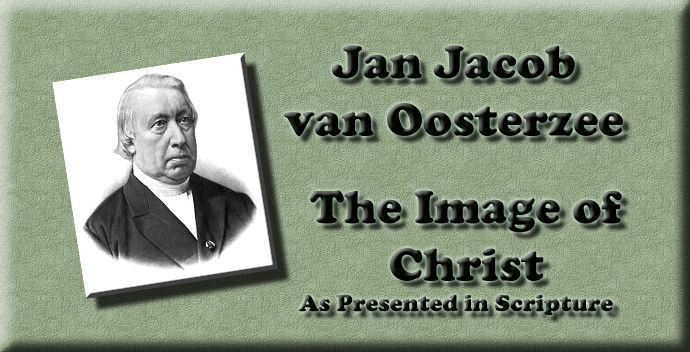
The Image of Christ
As Presented in Scripture
By J. J. Van Oosterzee
Part 1 - The Son of God Before His Incarnation
|
EVEN on the first glance at the person of our Lord there is seen to be an immense difference between Him and all who are born of woman. We men begin to live, only when we receive an existence from God through the medium of our earthly parents; a few months before, we existed only in the thoughts of God, not in reality. It was not our act, but our appointed lot, to belong to the human race; independently of our own willing and choosing, we have beheld the light of life.1 Our Lord, on the contrary, has, as well according to His own utterances as according to those of His inspired witnesses, existed in heaven with the Father, many centuries before His appearing upon earth, and even before the beginning of all things. It has indeed been sought to explain the unequivocal expressions, which we meet with especially in the writings of Paul and John, with regard to this His pre-existence, in such wise that they lose even all appearance of demonstrative force in relation to this mystery; but the arbitrary character of the measures resorted to is self-evident, and is already condemned, not before the tribunal of faith alone, but also before that of genuine science. It is only by doing violence to Scripture itself that any can efface from it the conception of a personal pre-existence of the Lord; he who will not read it there, deserves to be placed on the same level with those who can look upon white as black, or square as round.2 To make a writer say exactly the opposite of that which he manifestly intends to say is not allowed to any expositor. If, under the influence of philosophic doubt, any one will reject the distinct testimony of. the Gospel, this at least is intelligible; but let no one continue so partial and superficial as to assert that the truth in question is not presented in the Gospel. If then we come to the Lord, as did the Jews on one occasion,3 for an answer to the question, “Who art Thou?” He Himself gives to us the emphatic hint that we are to seek the key to the enigmas of His earthly appearing, above all things in His earlier, heavenly life. In order to understand the Son of man even to some extent, we must as far as possible learn to know Him as the only begotten Son of God; in order rightly to appreciate the exalted rank of the Son, we must view Him not merely in relation to the Father, but in relation to the whole Divine Nature, whose interpreter and visible manifestation He may be called. Yet even at this we cannot possibly stop short. The question now naturally arises, in what relation the Son of God, in whom the fulness of the Godhead dwells bodily, stands to the whole Creation existing outside Himself, whether visible or invisible. And if, again, so far as we know this creation, man is its crown and adornment, and if the assumed relationship of the Lord to our race can be sufficiently explained only from an earlier, originally existing relationship; the relation of the Son of God to Humanity, even before His incarnation, affords us a fresh object of reverent examination. Since, finally, there existed again in this humanity a nation, which, according to the testimony of irrefragable history, was century after century the bearer of God’s special revelations, and in the midst of which preparation was more directly and expressly made for the appearing of the Word in flesh; then finally the question engages our attention, whether (even before the fulness of the time) the Son of God stood in any nearer relation to this chosen people, and if so, in what relation. When this too has been duly examined, we may and must immediately pass over to the contemplation of the Incarnation of the Logos, with which our second main division begins. In this first division there are thus four circles of investigation laid down before us, of which the first is absolutely infinite, and each succeeding circle narrower than that which precedes, It is evident from the nature of the case, as well that the one section will occupy us much longer than the other, as that not all are equally attractive or easy to treat of. No single one is, however, we think, to be entirely passed over in silence; and just as little must we combine that which, perhaps, may be much better understood, if regarded as an entirely separate head. We therefore ‘treat of our subject in four distinct sections, the order of which will be sufficiently justified by what has been said above.
|
|
 |
 |
|
1) It is true the doctrine of the pre-existence of all human souls has found renewed advocacy within the most recent times, among others, on the part of the renowned theologian, Julius Miiller, who seeks in this way to explain the origin of sin; but the erroneous character of this philosophising has been displayed in a convincing manner on various sides. 2) Observe, for instance, how John, the greatest of the prophets, regards the “heavenly” as separated from him, the “earthly,” by a wide gulf (John iii. 31, 32; comp. John i, 1-18; viii. 58; xvii. 5; Phil. ii. 6—8; Col. i. 16, 17). 3) John viii. 25.
|
|
-
Site Navigation
 Home
Home What's New
What's New Bible
Bible Photos
Photos Hiking
Hiking E-Books
E-Books Genealogy
Genealogy Profile
Free Plug-ins You May Need
Profile
Free Plug-ins You May Need
 Get Java
Get Java.png) Get Flash
Get Flash Get 7-Zip
Get 7-Zip Get Acrobat Reader
Get Acrobat Reader Get TheWORD
Get TheWORD